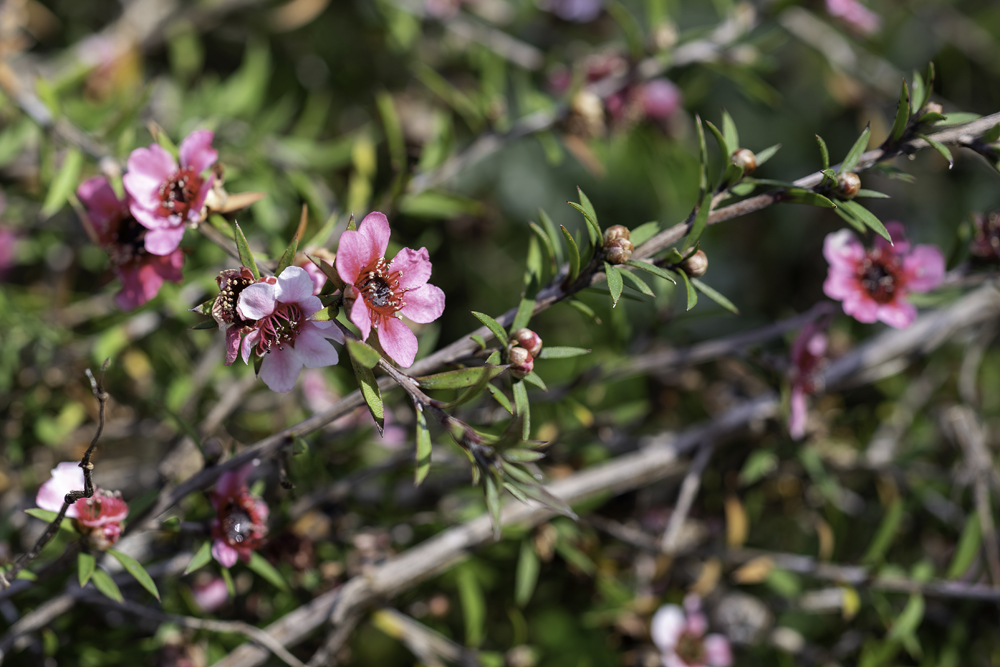Leptospermum
Common Name:
New Zealand Tea Tree

General Information:
Information on Leptospermum is taken from Lesniewicz’s “Bonsai in Your Home,” and Resnick’s “Bonsai,” with lots of additional information supplied by posts from Scott Barboza, Brent Walston, Fred Arnold and Iris Cohen, and my own Herculean efforts.
Leptospermum has the reputation of being the ultimate in forbidden bonsai. It is a lovely tree, with flowers which resemble tiny wild roses and spiky little evergreen leaves. The bark looks old rapidly, although it may take a while to thicken the trunk. Unfortunately, getting it to survive is a monumental task. These trees are native to New Zealand, Malaysia and Australia, but are now often found as hedge plants on the west coast of the US. The best bet for bonsai is Leptospermum humifusum, which is all- around tougher than the rest of the species. It is, however, reputedly harder to get to flower than other Leptos.
Lighting:
Needs lots of light. If kept indoors, requires a very bright location for survival. It does not respond well to fluorescent grow lights.
Temperature:
Never below 20F, but prefers it a bit cool in winter, 55-60 F. Keep in an airy location and keep away from heat sources. Can be kept indoors, but it is a challenge due to its light and air requirements. Hardy to zone 9.
Watering:
Keep uniformly moist. Leptos are touchy about watering. Lack of water is the easiest way to kill them - they do not wilt, but go from healthy to dead in a matter of hours. To make matters worse, they are also subject to root rot. Water when the soil dries slightly on the top, and keep your fingers crossed until you get the hang of it.
Feeding:
Use an acid fertilizer, such as Miracid. Fertilize infrequently with a very dilute solution, as they burn easily.
Pruning and wiring:
Suitable for most styles, but only L. humifusum makes a good cascade. Leptospermum has excellent mame potential, due to the naturally miniature leaves and flowers. Growth should be pinched back as needed. Care is needed when pruning, as these trees rarely bud back on old wood. Cutting back past the leaves will probably result in major branch die-back. L. humifusum is an exception - it will stand severe pruning. Leptospermum responds well to wiring, but repotting, pruning and wiring must be done at different times, or the tree will be over-stressed.
Propagation:
Take softwood cuttings during the growing season, July is usually a good time. Leave the terminals intact and take a short cutting of new growth about two or three inches. This new wood will be red, wood that has already turned brown will take very much longer to root. Protect against drying out, these cuttings will be very succulent. A poly tent or other cover will be necessary absent automatic mist. A low hormone is beneficial, rootone will work, I use Hormex number 3, which is 0.3% IBA. They should start rooting in ten days to two weeks.
Repotting:
Lesniewicz recommends very light root pruning only. The cumulative experience of the group suggests that this may be the bonsai understatement of the century. Avoid root pruning as long as possible. When the job can no longer be put off, shave off a thin slice from the bottom and repot. Do NOT try to untangle the roots. Treat with kid gloves for a few weeks. Next year, shave off a thin slice from one side of the root ball. The root mass can be reduced gradually in this fashion. Or sidestep the issue entirely by simply shaking off the old soil and repotting in a larger pot! Some recommend repotting in late winter before new growth starts. Others report more success repotting only in May or June. Plant in a well-drained mixture of sand, soil and humus. L. humifusum will stand far more root pruning than the species.
Pests and diseases:
No pests have been reported, perhaps because it doesn’t generally live long enough to fall prey to them!
Some species suitable for bonsai:
Leptospermum attenuatum: tea tree.
Leptospermum flavens: tea tree.
Leptospermum flavescens: tea tree.
Leptospermum humifusum: A white flowered, naturally arching variety which makes a good cascade or weeping bonsai. It is more hardy than the species - to 0F - and also much more tolerant of branch and root pruning.
Leptospermum laevigatum: Australian tea tree.
Leptospermum myrtaceae: Australian tea tree.
Leptospermum petersonii: tea tree.
Leptospermum scoparium: New Zealand tea tree, Manuka, tea tree, Australian myrtle.
Leptospermum scoparium ‘Kiwi’: A dwarf variety with pink flowers and very tight foliage that is more cold hardy than the species. Most useful for accent plants or mame.
Compiled by Sabrina Caine
